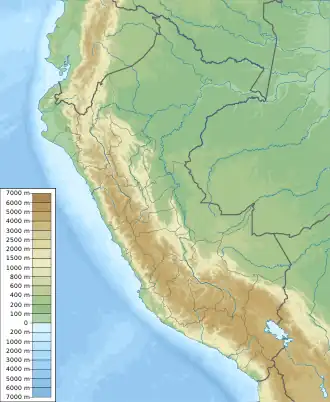1604 Arica earthquake
The 1604 Arica earthquake is an earthquake that occurred at 1:30 pm on November 24, 1604, offshore Arica, Chile (formerly part of the Spanish Empire). The estimated magnitude range is 8.0–8.5 Ms and possibly up to 9.0 Mw. It had a destructive tsunami that destroyed Arica and caused major damage at Arequipa. 1,200 km of coastline were affected by the tsunami.[3] The recorded effects of this earthquake are very similar to those for the 1868 Arica event, suggesting a similar magnitude and rupture area of the megathrust between the subducting Nazca Plate and the overriding South American Plate.[4] Tsunami deposits have been identified on the Chatham Islands that are likely to have been caused by a trans-Pacific tsunami caused by the 1604 earthquake.[5]
| UTC time | 1604-11-24 18:30:00 |
|---|---|
| Local date | November 24, 1604 |
| Local time | 13:30 |
| Magnitude | 8.0–8.5 Ms 9.0 Muk [1] |
| Depth | 30 km (19 mi)[2] |
| Epicenter | 18.5°S 70.4°W |
| Fault | Peru-Chile Trench |
| Type | Thrust fault |
| Areas affected | Arica, (then part of Chile), Arequipa, Peru |
| Max. intensity | XI (Extreme)[2] |
| Tsunami | Yes |
| Casualties | 100+[2] |
Tectonic setting
Off the coasts of Peru and Chile, the Nazca plate subducts underneath the South American plate along the Peru-Chile Trench. At the location of the earthquake, the convergence rate between the two plates is 6.0 cm (2 in)/year.[6] Large events at the plate boundary are relatively common, with similar large earthquakes occurring in 1687, 1784, 1868, and 2001. This earthquake cycle is considered to be bimodal, which means that the recurring earthquake is either a relatively small (but still large earthquake) or a truly large earthquake. Only the 1604 and 1868 events are considered to have been the latter truly colossal events.
Earthquake
Little is known about the earthquake, but it is interpreted to be similar in size and faulting to the 1868 Arica earthquake.[3] The cities of Arequipa, Tacna, Moquegua experienced shaking of Modified Mercalli Instensity VIII, while Cuzco and Ica experienced VI shaking.[1] The rupture length is thought to be between 400–450 km (249–280 mi) long.[7] It is believed that the 1604 event was unable to rupture north of the Nazca Ridge, which means that only the absolute largest earthquakes (such as 1868) can pass through this semi-persistent rupture barrier.[1]
Tsunami
The tsunami was widespread and impacted many countries. The tsunami, along with the 1868 event, is considered one of "the greatest historical tsunami events along the Perú-Chile Trench". Tsunami run-ups height were estimated to be around 16 m (52 ft) high.[8] It was recorded along at least 1,200 km (746 mi) and potentially up to 2,800 km (1,740 mi) of coastline in South America between Lima and Concepción.[4] In Oceania, the Chatham Islands have recorded what is very likely evidence of tsunami from this event as well.[5]
Damage
Arica was destroyed and rebuilt after the earthquake, while Arequipa was so severely damaged that only the San Francisco monastery remained standing.[3] In Pisco, only certain parts of the town experienced major damage.[4] Damage was reported across the Pacific ocean.[3] Overall, damages from the earthquake were comparable to the 1868 earthquake.[3]
References
- Wong et al. 2012.
- National Geophysical Data Center / World Data Service: NCEI/WDS Global Significant Earthquake Database. NOAA National Centers for Environmental Information (1972). "Significant Earthquake Information". NOAA National Centers for Environmental Information. doi:10.7289/V5TD9V7K. Retrieved 2022-03-30.
- Lomnitz 2004.
- Okal, Borrero & Synolakis 2006.
- Goff et al. 2010.
- Villegas-Lanza et al. 2016.
- Comte & Pardo 1991.
- Kulikov, Rabinovich & Thomson 2005.
Sources
- Comte, Diana; Pardo, M. (1 March 1991). "Reappraisal of great historical earthquakes in the Northern Chile and Southern Peru seismic gaps". Natural Hazards. 4: 23–44. doi:10.1007/BF00126557. S2CID 140190546. Retrieved 27 July 2022.
- Goff, J.; Nichol, S.; Chagué-Goff, C.; Horrocks, M.; McFadgen, B.; Cisternas, M. (2010). "Predecessor to New Zealand's largest historic trans-South Pacific tsunami of 1868 AD". Marine Geology. 275 (1–4): 155–165. doi:10.1016/j.margeo.2010.05.006.
- Kulikov, Evgueni A.; Rabinovich, Alexander B.; Thomson, Richard E. (June 2005). "Estimation of Tsunami Risk for the Coasts of Peru and Northern Chile". Natural Hazards. 35 (2): 185–209. doi:10.1007/s11069-004-4809-3. S2CID 140620121. Retrieved 7 November 2022.
- Lomnitz, C. (2004). "Major Earthquakes of Chile: A Historical Survey, 1535–1960". Seismological Research Letters. 75 (3): 368–378. doi:10.1785/gssrl.75.3.368.
- Okal, E.A.; Borrero, J.C.; Synolakis, C.E. (2006). "Evaluation of Tsunami Risk from Regional Earthquakes at Pisco, Peru". Bulletin of the Seismological Society of America. 96 (5): 1634–1648. doi:10.1785/0120050158.
- Villegas-Lanza, J. C.; Chlieh, M.; Cavalié, O.; Tavera, H.; Baby, P.; Chire-Chira, J.; Nocquet, J.-M. (24 September 2016). "Active tectonics of Peru: Heterogeneous interseismic coupling along the Nazca megathrust, rigid motion of the Peruvian Sliver, and Subandean shortening accommodation". J. Geophys. Res. Solid Earth. 121 (10): 7371–7394. doi:10.1002/2016JB013080. S2CID 132735222. Retrieved 26 July 2022.
- Wong, Ivan; Dober, Mark; Pezzopane, Silvio; Thomas, Patricia; Terra, Fabia (1 January 2012). Seismic hazard above the South America subduction zone in Southern Peru (PDF). 15th World Conference on Earthquake Engineering, Lisbon, Portugal. Retrieved 26 July 2022.
